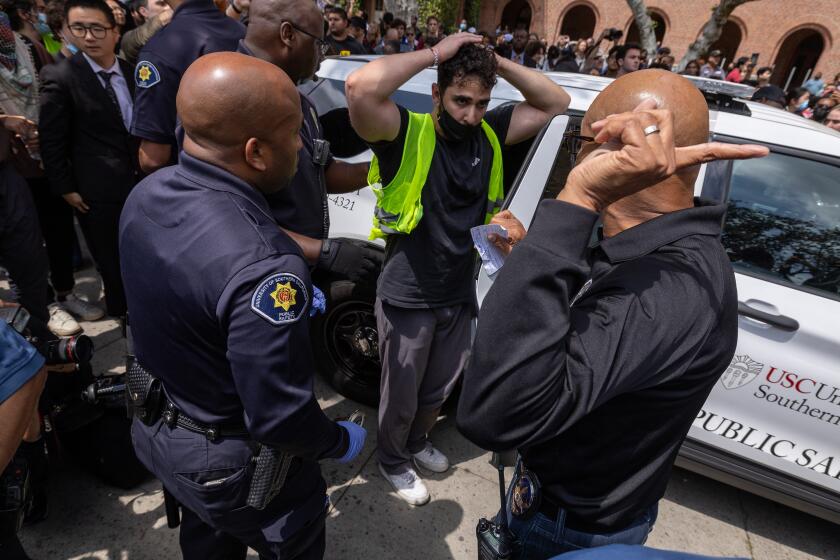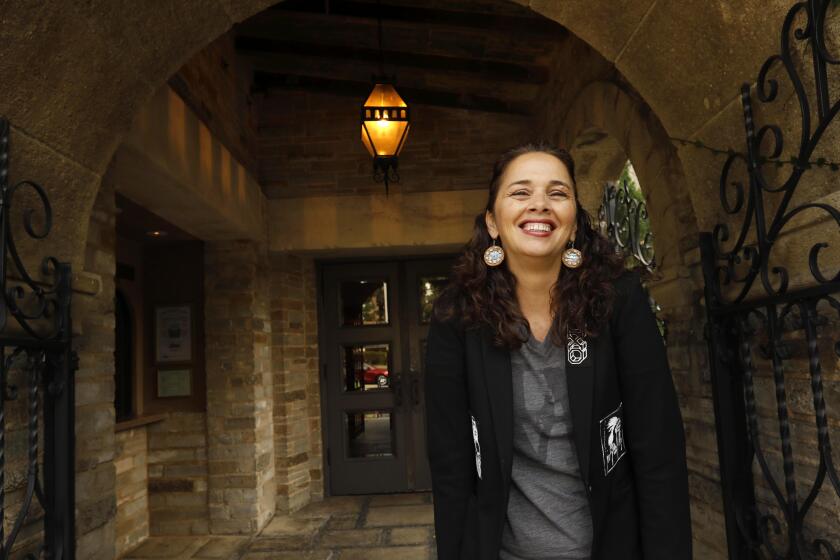Critic’s Notebook: Design tweaks can’t overcome Academy Museum’s dramatic flaws
For Kerry Brougher, newly named director of the Academy of Motion Picture Arts and Sciences’ planned film museum, the bubble may be nothing compared with the spaceship.
Brougher comes to the academy from the Hirshhorn in Washington, D.C., where one of his first tests as interim director was dealing with fallout from a failed proposal to install a $15-million inflatable bubble in the museum’s circular courtyard.
In Los Angeles, Brougher will inherit a new architectural challenge: what do with a major building project that isn’t in danger of being scrapped, as the bubble was, but has significant, even fundamental design flaws.
The academy hopes to break ground by the end of the year on a $300-million museum at the corner of Wilshire Boulevard and Fairfax Avenue, next to the Los Angeles County Museum of Art. Designed by Renzo Piano and the L.A. architect Zoltan Pali, it will remake the interior of the May Co. department store as a museum of Hollywood history.
PHOTOS: Best architecture moments 2013 | Christopher Hawthorne
It will also add a 1,000-seat dome-shaped theater, a structure Piano calls “the spaceship,” to the back of the 1939 landmark.
If Brougher and other academy leaders can compel the architects to reconcile the clear potential of the new wing’s interior spaces with its unconvincing, unwieldy exterior, they may be able to salvage the design before construction begins.
If not, they may well have an architectural flop on their hands when the museum opens in 2017 — not to mention the third disappointing Piano building within a quarter-mile radius.
The Hirshhorn bubble, designed by the architects Diller, Scofidio + Renfro, was proposed as a kind of architectural folly that would be inflated only a few weeks every year. The Academy Museum, with a budget 20 times larger, is slated for prominent intersection on Wilshire Boulevard that will include a Metro subway stop within a decade.
It will tell the story of how the movie business developed (and by extension how it helped shape Los Angeles). It ought to rival Frank Gehry’s Walt Disney Concert Hall as one of the most significant pieces of 21st-century architecture in Southern California.
INTERACTIVE: Tour Los Angeles’ boulevards
What the academy is preparing to build is several rungs below that level. Its architectural centerpiece, the spherical theater wing, is an oversized bauble that looks as if it’s just touching down for a short stay. As a piece of urban design the theater is trapped in a kind of retro-futuristic limbo, with little to say about contemporary Los Angeles.
Piano and the academy share a clear interest in making sure the project doesn’t repeat the errors (or even the formal vocabulary) of the architect’s recent buildings for LACMA, a pair of travertine-wrapped boxes practically in the shadow of the May Co.
The first to open, the Broad Contemporary Art Museum, is among the least assured of Piano’s many museum projects. The second, the Resnick Pavilion, is slightly better but still a far cry from Piano’s art-world masterpieces, the main gallery building at the Menil Collection in Houston and the Beyeler Foundation Museum near Basel, Switzerland.
Piano’s desire to redeem himself in Los Angeles after his LACMA misadventure is understandable. But it’s driven him to produce a misguided attempt at tourist-friendly architecture and one of the more strained designs of his long career.
Before he began comparing it to a spaceship, Piano described the spherical building, which will be clad in aluminum panels, as a soap bubble and a “planetarium of cinema.” He has said he was inspired by pictures of the blimps that once flew from this part of Los Angeles; the 1963 Cinerama Dome on Sunset Boulevard, by Welton Becket and Associates, is another clear precedent.
‘HER’: Spike Jonze’s refreshing take on a future L.A.
Propped up on a pair of stilts as it faces north, Piano’s theater looks less like a blimp or an update of Becket than a snub-nosed helmet — or a sleek, giant albino Pac-Man gobbling up the red carpet that stretches north beneath it toward 6th Street.
Several of the interior spaces promise to be more compelling. Part of the ground floor of the May Co. building will be dramatically cut away to reveal a theater at basement level.
Visitors who arrive for a screening or premiere, rather than to tour the museum, will take stairs or escalators to enter the dome. Or they’ll continue higher to a vast event space at the top of the new wing, beneath a huge glass canopy, offering views of the Hollywood Hills. The theater itself, wrapped in a concrete shell, will be among the most technically advanced in the country.
Recent changes by Piano and Pali have clarified the museum’s pedestrian connection to LACMA. The architects have also tucked a series of stairs and elevators, which had filled the space between the May Co. and the theater, inside the frame of the older building.
To be clear, the issue is not that the new wing fails to perfectly match the May Co., a key example of Streamline Moderne architecture by Albert C. Martin. The last thing Piano and Pali should aim for is some slavish replica of the older building.
PHOTOS: Designs of Pritzker Architecture Prize 2014 winner Shigeru Ban
The point is that the theater ought to be a thoughtful, resolved and confident piece of architecture in its own right. It should be for this decade in Los Angeles what the May Co. was for the 1930s, or the Cinerama Dome for the ‘60s: a clear and forward-looking expression of a particular moment in the city’s development.
In its current form the project lacks the sense of connection to site and to Southern California culture that makes Disney Hall, for all the otherworldly sheen of its exterior, feel entirely settled in its Bunker Hill location.
Without some improvements, in fact, the academy design, with its ready-for-liftoff symbolism, runs the risk of highlighting the cultural estrangement that has long existed between Los Angeles and the movie business.
The rift arguably began at the end of the silent era, with the advent of large, soundproof studios. (In 1946, Carey McWilliams described the “notorious cleavage between Hollywood and Los Angeles,” one he said began after Hollywood’s “retreat to the lots.”)
Studio campuses have tended to be walled compounds turned inward, away from the city. Hollywood executives have rarely been reliable civic philanthropists or supporters of important public architecture.
CRITICS’ PICKS: What to watch, where to go, what to eat
A more convincing version of the theater design would seek to knit the movie business and its history into the Los Angeles civic fabric — and at the same time, maybe, begin to make up for that track record of weak patronage.
It would leave the Hollywood populism — not a style Piano does well — to the exhibition designers working inside the museum. And it would cannily play off the lines of the May Co. building rather than working so strenuously to outdo it.
That approach would take full advantage of Piano’s particular skills, which have long had more to do with craftsmanship and careful manipulation of light and scale than with the production of eye-catching, crowd-pleasing shapes. He is an architect whose best work reaches the ethereal, even the sublime, by way of the rational.
It will be tough to fix the design without delaying the groundbreaking, to be sure. And in recent months the academy’s marketing campaign for the museum has used the Piano renderings as a centerpiece.
When academy President Cheryl Boone Isaacs spoke during the Oscars telecast last month, three images of the theater wing flashed on TV screens around the world. Architecture critics then raced to bash the design on Twitter, with at least two New York writers comparing it to a nuclear reactor.
It’s fair to assume that Brougher had a full briefing on the design and at least informally signed off on it.
But his return to Los Angeles, where he spent 14 years as a curator at the Museum of Contemporary Art, may be the last appropriate moment to take frank stock of the academy design — and maybe to save it from the architectural equivalent of a dismal opening weekend at the box office three years from now.
christopher.hawthorne@latimes.com
More to Read
The biggest entertainment stories
Get our big stories about Hollywood, film, television, music, arts, culture and more right in your inbox as soon as they publish.
You may occasionally receive promotional content from the Los Angeles Times.







